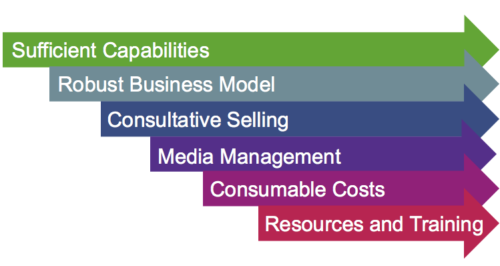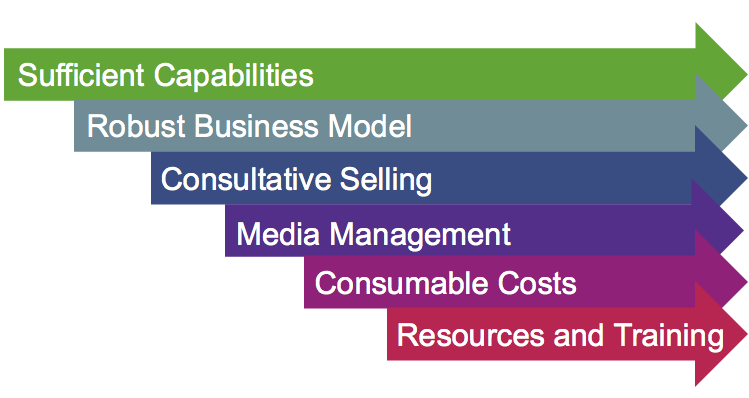Inkjet is having an impact on every segment of the print market. While adoption has been slower in some segments than others, the need for inkjet presses to stay running has caused a ripple effect across segments. Many print organizations who invest in inkjet quickly seek to diversify their book of business in order to fill their inkjet presses, minimize marginal running costs and maximize revenue.
Direct mailers have begun printing bills and statements while transaction printers have added direct mail and booklet printing to the mix. While commercial print organizations were the slowest to embrace inkjet, now that the largest players are in, they well positioned to add data-driven services such as direct mail and even transaction print. While most of the commercial print page cannibalization is expected to come from offset, some printers are eyeing some volumes that would have been produced on wide format devices while others are looking at expanding into packaging and labels. According to IT Strategies, graphic arts, packaging and industrial inkjet growth expectations are forecasted to grow from 2019 to 2023at CAGR of 20% and higher. Variable data, versioning and shrinking run lengths are all factors driving page volume from mono toner devices and offset presses to inkjet. Once a printer has invested in high quality production, data management and variable print capabilities, the traditional boundaries between segments can become blurred.
At the start, however, any provider seeking to integrate a new print segment into their existing one will be challenged. Growth markets such as direct mail, book, graphic arts, label, industrial and decoration will have different workflow requirements than your current work that must be researched carefully. From the sales approach to finishing, each new market requires a unique vision.
Whatever print market you are investigating, ask yourself the six questions below to determine if it is a strategic fit with your current book of business.
We call these the Sensible Six.
1. Do I understand (and have) the capabilities needed?
Each market has different requirements from turn times to coating. Markets with higher graphic and creative needs may come with higher client expectations than your current book of business.
Fully investigate each prospective market to understand the how the product you are printing will be used. Things that sound the same can still be different. Direct mail post cards require a post coat to protect the print, whereas labels may require different coatings to help with moisture resistance while also being food safe. Other media may be resin capped, or even post formed, which could require a softer cure. All coatings, but all different.
Your contract may be for printing and coating only, with finishing or converting performed elsewhere. Even though you play a part in the process, you may be required to fully understand the compatibility of your finished product with the next step in the supply chain.
Moving into markets which have a commercial audience such as direct mail, graphic arts and packaging takes a clear understanding of expectations in print and finished quality. We know by now inkjet is different, but if you currently print for the book or direct mail market, there are some print aspects of inkjet which are deemed part of the process and are accepted. For printing which encloses or labels a product, expectations are higher and those which were accepted in direct mail may not be for direct sale products.
2.Do I have a friendly/robust workflow?
On-boarding clients in new markets requires streamlined workflows that make it easy for customers to work with you. Adding a new market can overwhelm your incoming preflight process if reviewing files for process compatibility is not automated. Reviewing every file received or having to fix files downstream will cost you money and downtime. This was a common complaint from transaction printers who started receiving large PDF files from clients and didn’t have a pre-flight process at all.
Markets also can differ in composition, color space, graphic elements and finished file sizes. Research each prospective market to fully understand its common file types as they can be very different than your current standards. Static incoming file sizes can be considerably larger if working in graphic arts or packaging and larger still if variable data or imagery is included. These gig or larger files can completely choke file transfer or rasterizing processes within a workflow.
On-boarding clients in new markets requires more communication to ensure a streamlined process without adding manual touchpoints. More attention and touch points cost you time and money.
3. Do we have salespeople or consultants?
As inkjet has expanded into every print market, it has blurred the boundaries. Inkjet is being used in campaigns which compliment offset or digital toner. Commercial, direct mail and direct to product are co-mingling to form custom kits for mailings and giveaways. Selling these integrated projects requires a consultative sales approach. You may have been offered one piece of a project without knowing there are other pieces which you can provide. Consultative selling is asking about the end-to-end process of the project or campaign and providing assistance in streamlining or improving the project, as well as securing production business.
Consultative selling can only work if your sales team can speak the language of the specific markets and make benefits of your inkjet process and plant capabilities relevant. Sales should have a clear vision of your capabilities and how they relate to the customer’s project and print quality expectations. This includes color matching, print quality and clarity for each device, process and finishing line you sell. Misinterpretation can hurt your bottom line and reputation.
4. How will it affect media management?
Expanding your market mix will most likely add to your media management. You will have various surfaces, grades, and thicknesses of media which will have to be managed in the warehouse as well as on the inkjet device itself.
Each media and its surface must be handled differently to ensure moisture, temperature, static, dust and dirt does not cause additional preparation, throughput or compatibility issues when printed.
Additional media management may be required for downstream finishing, molding, cutting or converting if applicable.
5. How will it impact my consumables costs?
It’s no secret that aqueous and UV inkjet inks are more expensive than offset inks. Even within CMYK, Cyan, magenta and yellow can be almost double the cost of black. Expanded gamut or demand colors are significantly higher than process and can greatly increase your overall coverage costs if not managed correctly.
When moving into graphic arts, industrial or packaging, the amount of ink used can increase by 800% or higher relative to less coverage-intensive markets. Along with higher coverage, these markets have higher print quality expectations which can require a color proof directly off the inkjet device itself. Yes, using your multi-million inkjet printer as a proofer is crazy and creates loss of production time, especially if media and configuration changes are required. But, due to the drop pattern and color gamut differences of inkjet, it may be necessary to generate proofs to close that large account. (See questions 1 and 2 again!)
Color gamut requirements and higher coverages may drive you toward media with pretreatments or specialty surfaces to optimize ink usage, which can increase media costs.
A market’s use of porous and nonporous media may require pretreatments such as primers (jetted or flood coat) or corona, flame or plasma. While adding fluids in line can be less expensive than buying an inkjet treated or coated sheet, in-line treatments do add fluid, machinery, energy and maintenance costs. Depending on the configuration, preparing the media for print may also require slower production speeds and the addition of drying power or curing to your printer configuration.
6. Are we prepared to partner with our customers?
Entering new markets will require you to learn from your clients. At the same time, training customers and prospects on inkjet capabilities creates a connection with the client’s creative organization.
Print buyers and designers are working with multiple print platforms and digital channels. A clear understanding of differences is important to streamlining incoming files. A clear understanding of benefits is critical becoming part of their budget.
Your staff must be well versed in the benefits which inkjet can bring to a customer’s current or future projects in order to partner and grow.
Providing resources and training to customers and internal staff is important throughout the market evaluation and entry process. On an ongoing basis, discuss each project to align elements to flow efficiently. When each job is complete, review things which went well and what you and the customer could do to make the next job run even more efficiently. Customers will appreciate the consultative approach to turning their jobs into successful finished campaigns.

When adding any new market to your existing book of business, streamlining the process through communication and training will save you headaches from surprises and increased costs.
Remember, don’t overlook the small things- they will cost you in the end.

